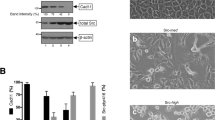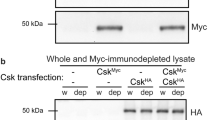Abstract
THE colony-stimulating factor-1 receptor (CSF-1 R) mediates its pleiotropic effects through the coupling of its ligand-activated tyrosine kinase to multiple intracellular effector proteins, whose combined actions determine the magnitude and specificity of the biological response. The interaction of cytoplasmic signalling molecules with CSF-1 R is mediated in part by sequence motifs flanking sites of receptor tyrosine phosphorylation1. Mutation of an autophosphorylation site at tyrosine 809 in the cytoplasmic domain of human CSF-1R does not significantly reduce its ligand-stimulated tyrosine kinase activity, binding to phosphatidylinositol 3-kinase, or induction of the immediate early response genes, c-fos and junB (ref. 2). Unlike cells bearing wild-type receptors, mouse NIH3T3 cells expressing mutant CSF-lR(Phe 809) were unable to grow in serum-free medium containing human recombinant CSF-1 and did not form colonies in semi-solid medium in its presence. CSF-1 induction of c-myc messenger RNA in these cells was impaired, but enforced expression of an exogenous c-myc gene restored their ability to proliferate in response to the growth factor. These studies demonstrate a receptor-mediated bifurcation of intracellular signal transduction pathways during the immediate early response and assign a central role for c-myc in CSF-1-induced mitogenesis.
This is a preview of subscription content, access via your institution
Access options
Subscribe to this journal
Receive 51 print issues and online access
$199.00 per year
only $3.90 per issue
Buy this article
- Purchase on Springer Link
- Instant access to full article PDF
Prices may be subject to local taxes which are calculated during checkout
Similar content being viewed by others
References
Cantley, L. C. et al. Cell 64, 281–302 (1991).
Roussel, M. F., Shurtleff, S. A., Downing, J. R. & Sherr, C. J. Proc. natn. Acad. Sci. U.S.A. 87, 6738–6742 (1990).
Kelly, K., Cochran, B., Stiles, C. D. & Leder, P. Cell 35, 603–610 (1983).
Muller, R., Bravo, R., Burckhardt, J. & Curran, T. Nature 312, 716–720 (1984).
Armelin, H. A. et al. Nature 310, 655–660 (1984).
Blackwood, E. M. & Eisenman, R. N. Science 251, 1211–1217 (1991).
Roussel, M. F. & Sherr, C. J. Proc. natn. Acad. Sci. U.S.A. 86, 7924–7927 (1989).
Dean, M. et al. J. biol. Chem. 261, 9161–9166 (1986).
Cleveland, J. L., Dean, M., Rosenberg, N., Wang, J. Y. J. & Rapp, U. R. Molec. cell. Biol. 9, 5685–5695 (1989).
Eilers, M., Schirm, S. & Bishop, J. M. EMBO J. 10, 133–141 (1991).
Pietenpol, J. A., Holt, J. T., Stein, R. W. & Moses, H. L. Proc. natn. Acad. Sci. U.S.A. 87, 3758–3762 (1990).
Heikkila, R. et al. Nature 328, 445–449 (1987).
Pietenpol, J. A. et al. Cell 61, 777–785 (1990).
Baccarini, M., Sabatini, D. M., App, H., Rapp, U. R. & Stanley, E. R. EMBO J. 9, 3649–3657 (1990).
Jamal, S. & Ziff, E. B. Nature 344, 463–466 (1990).
Siegfried, Z. & Ziff, E. B. Molec. cell. Biol. 10, 6073–6078 (1990).
Rapp, U. R. et al. J. Virol. 55, 23–33 (1985).
Blasi, E. et al. Nature 318, 667–670 (1985).
Graf, T. et al. Cell 45, 357–364 (1986).
Principato, M. et al. Molec. cell. Biol. 10, 3562–3568 (1990).
Downing, J. R. et al. EMBO J. 8, 3345–3350 (1989).
Reedijk, M., Liu, X. & Pawson, T. Molec. cell. biol. 10, 5601–5608 (1990).
Dean, M., Cleveland, J. L., Rapp, U. R. & Ihle, J. N. Oncogene Res. 1, 279–296 (1987).
Roussel, M. F. et al. Nature 325, 549–552 (1987).
Author information
Authors and Affiliations
Rights and permissions
About this article
Cite this article
Roussel, M., Cleveland, J., Shurtleff, S. et al. Myc rescue of a mutant CSF-1 receptor impaired in mitogenic signalling. Nature 353, 361–363 (1991). https://doi.org/10.1038/353361a0
Received:
Accepted:
Issue Date:
DOI: https://doi.org/10.1038/353361a0
This article is cited by
-
Reflecting on 25 years with MYC
Nature Reviews Cancer (2008)
-
Myc targets Cks1 to provoke the suppression of p27Kip1, proliferation and lymphomagenesis
The EMBO Journal (2007)
-
Ink4c is dispensable for tumor suppression in Myc-induced B-cell lymphomagenesis
Oncogene (2007)
-
Distinct role for c-kit receptor tyrosine kinase and SgIGSF adhesion molecule in attachment of mast cells to fibroblasts
Laboratory Investigation (2005)
-
A unique E1-E2 interaction required for optimal conjugation of the ubiquitin-like protein NEDD8
Nature Structural & Molecular Biology (2004)
Comments
By submitting a comment you agree to abide by our Terms and Community Guidelines. If you find something abusive or that does not comply with our terms or guidelines please flag it as inappropriate.



